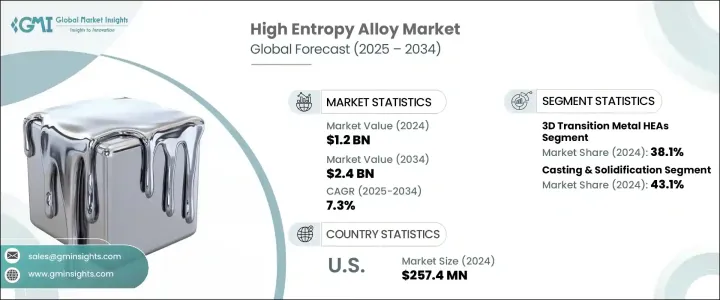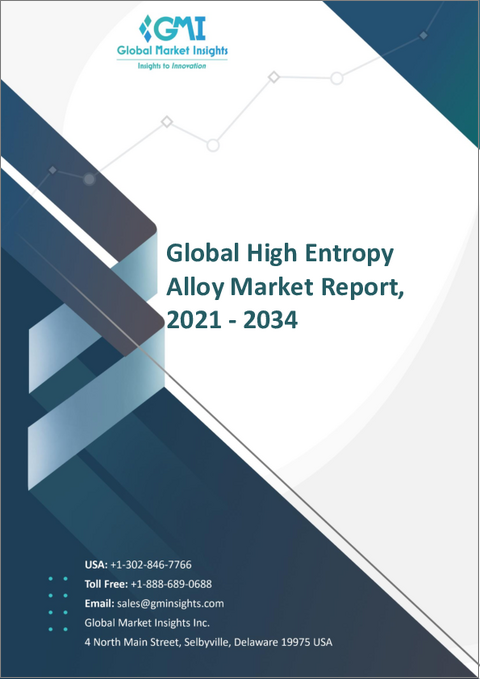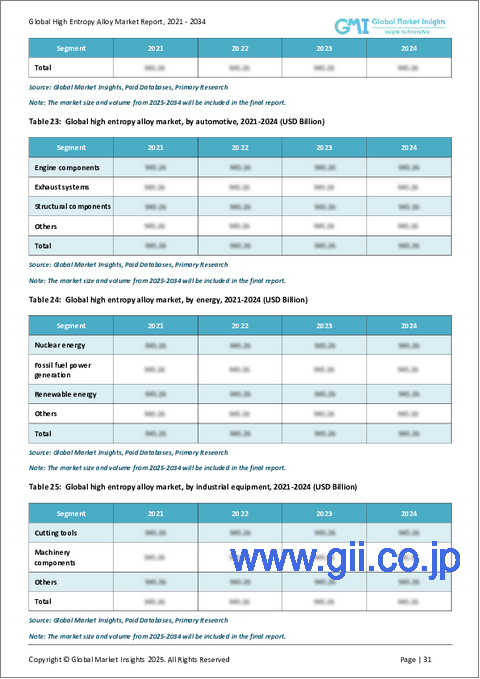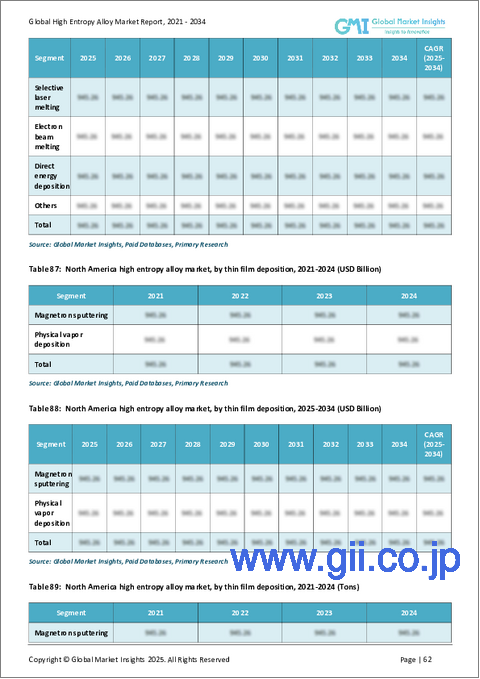|
|
市場調査レポート
商品コード
1766271
高エントロピー合金の市場機会、成長促進要因、産業動向分析、2025~2034年予測High Entropy Alloy Market Opportunity, Growth Drivers, Industry Trend Analysis, and Forecast 2025 - 2034 |
||||||
カスタマイズ可能
|
|||||||
| 高エントロピー合金の市場機会、成長促進要因、産業動向分析、2025~2034年予測 |
|
出版日: 2025年06月12日
発行: Global Market Insights Inc.
ページ情報: 英文 220 Pages
納期: 2~3営業日
|
全表示
- 概要
- 目次
世界の高エントロピー合金市場は2024年に12億米ドルと評価され、CAGR 7.3%で成長し、2034年には24億米ドルに達すると推定されています。
これらの合金は、ほぼ等しい比率で混合された5種類以上の主要元素で構成され、機械的強度、耐食性、熱安定性などのユニークな組み合わせを記載しています。これらの合金の人気が高まっているのは、特に摩耗、熱、構造疲労に対する回復力が要求される環境において、従来型合金よりも性能が優れていることに起因しています。様々なセグメントでの採用が増加している背景には、材料の耐久性を向上させ、軽量化し、部品の寿命を延ばす方法を模索する研究開発の急増があります。

産業がエネルギー効率と長期性能を優先する中で、より軽く、より強く、より温度耐性に優れた材料の開発に注力することは極めて重要です。その結果、高エントロピー合金は、先進的材料特性が譲れない次世代部品製造において、急速に不可欠なものとなりつつあります。これらの材料は、モビリティシステムや大型インフラからエネルギー集約型機器に使用される部品に至るまで、従来型用途と新たな用途の両方において強い可能性を示しています。材料技術革新への投資が拡大し、進化する性能ベンチマークを満たす必要性が高まる中、市場は産業への普及に向けて着実にシフトしています。
| 市場範囲 | |
|---|---|
| 開始年 | 2024年 |
| 予測年 | 2025~2034年 |
| 開始金額 | 12億米ドル |
| 予測金額 | 24億米ドル |
| CAGR | 7.3% |
2024年、三次元遷移金属高エントロピー合金は、合金タイプ別市場シェア全体の38.1%を占めました。これらの合金は、一般的にFe、Ni、Co、Cr、Mnなどの元素を使用して作られ、機械的弾力性、耐食性、経済性でよく知られており、様々な産業セグメントでの用途に理想的です。粉末冶金や積層造形プロセスとの適合性は、その用途をさらに広げています。これらの方法は、複雑な部品の製造を可能にし、プロトタイピングを合理化します。これは、迅速な開発サイクルと耐久性のあるプロトタイプを必要とする産業では貴重なものです。さらに、これらの合金は優れた耐放射線性と高い熱伝導性を示すため、極端な温度や動作条件にさらされるシステムに適しています。
製造方法別では、鋳造・凝固プロセスが2024年のシェア43.1%で市場をリードしています。この優位性は、特に既存の冶金システムに統合した場合の、これらの技術の拡大性とコスト効率による。このプロセスは大量生産を支えるだけでなく、結晶粒構造の微細化や相の安定化においても重要な役割を果たしており、これらは高い熱応力や機械的応力下で長期的な材料性能を確保するために不可欠です。粉末冶金と積層造形は引き続き支持を集めているが、鋳造は複雑な設計のバルク部品を製造するための最もコスト効率の高いアプローチであり続けています。
特性別に分類すると、優れた機械的特性を持つ合金が2024年に最大の市場シェアを占めます。高い引張強度、耐衝撃性、延性などのこれらの特性により、部品は劣化することなく継続的な機械的負荷に耐えることができます。高エントロピー合金のユニークな原子構造は、固溶体強化や変形抵抗に寄与しており、これが、繰り返し応力や過酷な使用条件下での構造的完全性が要求される用途で多用される理由です。部品を軽量化しながら性能を維持する能力は、メーカーが厳しい規制や安全基準を満たすのに役立っています。
用途別では、構造用途が2024年の市場で最大のシェアを占めています。これらの合金は、その耐疲労性と機械的安定性により、大きな荷重に耐えなければならない部品や、高ストレス環境で作動する部品に頻繁に選ばれています。この材料の多相構造は靭性を向上させ、高衝撃使用時の破損防止に役立ちます。その結果、これらの合金は、耐久性、構造的耐久性、複数のヘビーユース用途にわたる長い耐用年数を目的として設計されたシステムにおいて、地歩を固めつつあります。
最終用途産業を見ると、2024年には航空宇宙と防衛が世界市場をリードしました。この優位性は、軽量特性と高い機械的強度と耐熱性を兼ね備えた材料に対するこのセグメントの継続的な需要を反映しています。急速に変化する熱環境で使用される部品には、耐酸化性と耐クリープ性の強化が必要であり、これらの合金はそれを提供できます。過酷な条件下での信頼性が証明されているため、このセグメント、特にミッションクリティカルなシステムへの投資と技術革新が続いています。
地域別では、米国が2024年に2億5,740万米ドルの市場規模を記録し、北米のをリードしています。同国は、連邦政府が資金提供する研究プログラムにおいて強固な基盤を持っており、航空宇宙、防衛、エネルギー、自動車産業全体で需要が高まっていることが、広く普及する原動力となっています。これらのセグメントでは、機械的・熱的負荷の下で安定した性能を発揮する材料に大きく依存しているため、高エントロピー合金は先端製造業における戦略的資産となっています。
世界の競合情勢は中程度にサブセグメンテーションされており、複数の企業がニッチなポジションを占めています。各社は、独自の合金配合、次世代加工技術、厳格な産業品質基準の遵守に注力し、優位性を保っています。技術革新、カスタマイズ、材料性能は、依然としてこのセグメントの競合を左右する中核セグメントです。
目次
第1章 調査手法と範囲
第2章 エグゼクティブサマリー
第3章 産業考察
- エコシステム分析
- バリューチェーンに影響を与える要因
- 利益率分析
- ディスラプション
- 将来の展望
- 製造業者
- 販売代理店
- トランプ政権による関税への影響
- 貿易への影響
- 貿易量の混乱
- 報復措置
- 産業への影響
- 供給側の影響(原料)
- 主要原料の価格変動
- サプライチェーンの再構築
- 生産コストへの影響
- 需要側の影響(販売価格)
- 最終市場への価格伝達
- 市場シェアの動向
- 消費者の反応パターン
- 供給側の影響(原料)
- 影響を受ける主要企業
- 戦略的な産業対応
- サプライチェーンの再構成
- 価格設定と製品戦略
- 施策関与
- 展望と今後の検討事項
- 貿易への影響
- 貿易統計(HSコード)(注:上記の貿易統計は主要国についてのみ提供されます)
- 主要輸出国
- 主要輸入国
- 影響要因
- 促進要因
- 航空宇宙と防衛セグメントにおける軽量かつ高強度の材料に対する需要の高まり
- 原子炉とエネルギー貯蔵用途の先端材料への投資増加
- 熱安定性と耐腐食性により電気自動車部品への使用が拡大
- 産業の潜在的リスク・課題
- 複雑な合金組成と特殊な加工技術による高生産コスト
- 商業規模の生産インフラとサプライチェーンの統合が限られている
- 産業全体でのテストとパフォーマンス指標の標準化の欠如
- 市場機会
- 促進要因
- 利益率分析
- 製造プロセス分析
- 鋳造と凝固
- 粉末冶金
- 積層造形
- 機械式アロイング
- その他の製造方法
- 技術の進歩と革新
- 規制情勢
- 材料検査基準
- 産業固有の認証要件
- 環境規制
- 先端材料の輸出入規制
- 成長可能性分析
- 価格分析(米ドル/トン)2021~2034年
- ポーター分析
- PESTEL分析
第4章 競合情勢
- イントロダクション
- 企業の市場シェア分析
- 戦略枠組み
- 合併と買収
- ジョイントベンチャーとコラボレーション
- 新製品開発
- 拡大戦略
- 競合ベンチマーキング
- ベンダー情勢
- 競合ポジショニングマトリックス
- 戦略的ダッシュボード
- 特許分析とイノベーション評価
- 研究開発集約度分析
第5章 市場推定・予測、合金タイプ別、2021~2034年
- 主要動向
- 3d遷移金属HEA
- CoCrFeMnNi(カンター合金)
- コバルトクロム鉄ニッケル
- コバルトクロム鉄ニッケルマンガン
- その他
- 耐火金属HEA
- NbMoTaW
- VNbMoTaW
- ハフニウムニブタンチタンジルコン
- その他
- 軽金属HEA
- AlMgLiCaZn
- AlLiMgScTi
- その他
- アルミニウム含有HEA
- アルコクロム鉄ニッケル
- AlCoCrCuFeNi
- その他
- 貴金属HEA
- 希土類元素含有HEA
- その他
第6章 市場推定・予測、製造方法別、2021~2034年
- 主要動向
- 鋳造と凝固
- アーク溶解
- 誘導溶解
- 真空誘導溶解
- 粉末冶金
- ガスアトマイゼーション
- 機械式アロイング
- 放電プラズマ焼結
- 熱間静水圧プレス
- その他
- 積層造形
- 選択的レーザー溶融
- 電子ビーム溶解
- 直接エネルギー蓄積
- その他
- 薄膜堆積
- マグネトロンスパッタリング
- 物理蒸着
- その他
第7章 市場推定・予測、特性別、2021~2034年
- 主要動向
- 機械的特性
- 高強度
- 高硬度
- 高い延性
- 耐摩耗性
- その他
- 熱安定性
- 高温強度
- クリープ抵抗
- 熱膨張制御
- その他
- 耐腐食性と耐酸化性
- 耐水性腐食性
- 高温酸化耐性
- その他
- 磁気特性
- 電気特性
- 放射線耐性
- その他
第8章 市場推定・予測、用途別、2021~2034年
- 主要動向
- 構造用途
- 高温構造部品
- 軽量構造部品
- その他
- 機能用途
- 磁気
- 電気
- 触媒
- その他
- コーティングと表面処理
- 耐摩耗コーティング
- 耐腐食コーティング
- 遮熱コーティング
- その他
- 極限環境用途
- 極低温
- 高温
- 高放射線
- その他
- その他
第9章 市場推定・予測、最終用途産業別、2021~2034年
- 主要動向
- 航空宇宙と防衛
- 航空機部品
- 推進システム
- 防衛装備
- 宇宙
- その他
- 自動車
- エンジン部品
- 排気システム
- 構造部品
- その他
- エネルギー
- 原子力エネルギー
- 化石燃料発電
- 再生可能エネルギー
- その他
- 産業機器
- 切削工具
- 機械部品
- その他
- エレクトロニクスと半導体
- 化学と石油化学
- 医療とヘルスケア
- 調査と学術
- その他
第10章 市場推定・予測、地域別、2021~2034年
- 主要動向
- 北米
- 米国
- カナダ
- 欧州
- ドイツ
- 英国
- フランス
- スペイン
- イタリア
- アジア太平洋
- 中国
- インド
- 日本
- オーストラリア
- 韓国
- ラテンアメリカ
- ブラジル
- メキシコ
- アルゼンチン
- 中東・アフリカ
- サウジアラビア
- 南アフリカ
- アラブ首長国連邦
第11章 企業プロファイル
- Alcoa Corporation
- AMETEK Specialty Metal Products
- Aperam S.A.
- ATI Metals
- Aubert & Duval
- Carpenter Technology Corporation
- Daido Steel
- Eramet Group
- H.C. Starck GmbH
- Haynes International
- High Entropy Alloys Inc.
- Hitachi Metals
- Hμganμs AB
- IHI Corporation
- Kennametal
- Materion Corporation
- Metalysis
- Nippon Yakin Kogyo
- Oerlikon Metco
- Plansee SE
- Praxair Surface Technologies
- Questek Innovations
- Sandvik AB
- Special Metals Corporation
- VDM Metals GmbH
The Global High Entropy Alloy Market was valued at USD 1.2 billion in 2024 and is estimated to grow at a CAGR of 7.3% to reach USD 2.4 billion by 2034. These alloys are composed of five or more principal elements mixed in near-equal ratios, offering a unique combination of mechanical strength, corrosion resistance, and thermal stability. Their growing popularity stems from their performance advantages over conventional alloys, especially in environments that demand resilience to wear, heat, and structural fatigue. This increasing adoption across multiple sectors is backed by a surge in research and development, as manufacturers look for ways to improve material durability, reduce weight, and enhance component longevity.

The focus on developing lighter, stronger, and more temperature-tolerant materials is critical as industries prioritize energy efficiency and long-term performance. As a result, high entropy alloys are quickly becoming essential in next-generation component manufacturing, where advanced material properties are non-negotiable. These materials are showing strong potential in both traditional and emerging applications, ranging from mobility systems and heavy-duty infrastructure to components used in energy-intensive equipment. With growing investment in material innovation and the need to meet evolving performance benchmarks, the market is witnessing a steady shift toward widespread industrial deployment.
| Market Scope | |
|---|---|
| Start Year | 2024 |
| Forecast Year | 2025-2034 |
| Start Value | $1.2 Billion |
| Forecast Value | $2.4 Billion |
| CAGR | 7.3% |
In 2024, 3D transition metal high entropy alloys accounted for 38.1% of the overall market share by alloy type. These alloys, typically made using elements such as Fe, Ni, Co, Cr, and Mn, are well-known for their mechanical resilience, corrosion resistance, and economic viability, making them ideal for applications across various industries. Their compatibility with powder metallurgy and additive manufacturing processes further broadens their usability. These methods enable the production of complex parts and streamline prototyping, which is valuable in industries that demand quick development cycles and durable prototypes. Additionally, these alloys exhibit excellent radiation tolerance and high thermal conductivity, making them suitable for systems exposed to extreme temperatures and operating conditions.
By manufacturing method, casting and solidification processes led the market with a 43.1% share in 2024. This dominance is driven by the scalability and cost-efficiency of these techniques, especially when integrated into existing metallurgical systems. The process not only supports mass production but also plays a vital role in refining grain structure and stabilizing phases, which are essential for ensuring long-term material performance under high thermal and mechanical stress. Although powder metallurgy and additive manufacturing continue to gain traction, casting remains the most cost-effective approach for producing bulk components with intricate designs.
When categorized by property, alloys with superior mechanical characteristics held the largest market share in 2024. These properties-such as high tensile strength, impact resistance, and ductility-allow components to endure continuous mechanical loading without degradation. The unique atomic structure of high entropy alloys contributes to their solid-solution strengthening and resistance to deformation, which is why they are heavily used in applications that require structural integrity under cyclic stress and intense operational conditions. Their ability to maintain performance while reducing component weight helps manufacturers meet demanding regulatory and safety standards.
In terms of application, structural uses represented the largest share of the market in 2024. These alloys are frequently chosen for components that must bear significant load or operate in high-stress environments due to their fatigue resistance and mechanical stability. The materials' multi-phase structures offer enhanced toughness, which helps prevent failure during high-impact use. As a result, these alloys are gaining ground in systems designed for durability, structural endurance, and long service life across multiple heavy-use applications.
Looking at end-use industries, aerospace and defense led the global market in 2024. This dominance reflects the sector's ongoing demand for materials that combine lightweight characteristics with high mechanical strength and thermal resistance. Components that operate in rapidly changing thermal environments require enhanced oxidation and creep resistance, which these alloys can provide. Their proven reliability in harsh conditions continues to drive investment and innovation in the sector, particularly for mission-critical systems.
Regionally, the United States recorded a market value of USD 257.4 million in 2024, leading North America. The country's strong foundation in federally funded research programs and the growing demand across aerospace, defense, energy, and automotive industries has driven widespread adoption. These sectors rely heavily on materials that perform consistently under mechanical and thermal loads, making high entropy alloys a strategic asset in advanced manufacturing.
The competitive landscape of the global high entropy alloy market is moderately fragmented, with several players holding niche positions. Companies are focusing on proprietary alloy formulations, next-generation processing techniques, and adherence to strict industry quality standards to stay ahead. Innovation, customization, and material performance remain the core areas influencing competitive positioning across the sector.
Table of Contents
Chapter 1 Methodology & Scope
- 1.1 Market scope & definition
- 1.2 Base estimates & calculations
- 1.3 Forecast calculation
- 1.4 Data sources
- 1.4.1 Primary
- 1.4.2 Secondary
- 1.4.2.1 Paid sources
- 1.4.2.2 Public sources
- 1.5 Primary research and validation
- 1.5.1 Primary sources
- 1.5.2 Data mining sources
Chapter 2 Executive Summary
- 2.1 Industry synopsis, 2021-2034
Chapter 3 Industry Insights
- 3.1 Industry ecosystem analysis
- 3.1.1 Factor affecting the value chain
- 3.1.2 Profit margin analysis
- 3.1.3 Disruptions
- 3.1.4 Future outlook
- 3.1.5 Manufacturers
- 3.1.6 Distributors
- 3.2 Trump administration tariffs
- 3.2.1 Impact on trade
- 3.2.1.1 Trade volume disruptions
- 3.2.1.2 Retaliatory measures
- 3.2.2 Impact on the industry
- 3.2.2.1 Supply-side impact (raw materials)
- 3.2.2.1.1 Price volatility in key materials
- 3.2.2.1.2 Supply chain restructuring
- 3.2.2.1.3 Production cost implications
- 3.2.2.2 Demand-side impact (selling price)
- 3.2.2.2.1 Price transmission to end markets
- 3.2.2.2.2 Market share dynamics
- 3.2.2.2.3 Consumer response patterns
- 3.2.2.1 Supply-side impact (raw materials)
- 3.2.3 Key companies impacted
- 3.2.4 Strategic industry responses
- 3.2.4.1 Supply chain reconfiguration
- 3.2.4.2 Pricing and product strategies
- 3.2.4.3 Policy engagement
- 3.2.5 Outlook and future considerations
- 3.2.1 Impact on trade
- 3.3 Trade statistics (HS Code)Note: the above trade statistics will be provided for key countries only.
- 3.3.1 Major exporting countries
- 3.3.2 Major importing countries
- 3.4 Impact forces
- 3.4.1 Growth drivers
- 3.4.1.1 Rising demand for lightweight and high-strength materials in aerospace and defense sectors
- 3.4.1.2 Increased investment in advanced materials for nuclear reactor and energy storage applications
- 3.4.1.3 Expanding usage in electric vehicle components due to thermal stability and corrosion resistance
- 3.4.2 Industry pitfalls & challenges
- 3.4.2.1 High production costs due to complex alloy compositions and specialized processing techniques
- 3.4.2.2 Limited availability of commercial-scale production infrastructure and supply chain integration
- 3.4.2.3 Lack of standardization in testing and performance metrics across industries
- 3.4.3 Market opportunities
- 3.4.1 Growth drivers
- 3.5 Profit margin analysis
- 3.5.1 Manufacturing process analysis
- 3.5.2 Casting & solidification
- 3.5.3 Powder metallurgy
- 3.5.4 Additive manufacturing
- 3.5.5 Mechanical alloying
- 3.5.6 Other manufacturing methods
- 3.6 Technological advancements and innovations
- 3.7 Regulatory landscape
- 3.7.1 Material testing standards
- 3.7.2 Industry-specific certification requirements
- 3.7.3 Environmental regulations
- 3.7.4 Import/export regulations for advanced materials
- 3.8 Growth potential analysis
- 3.9 Pricing analysis (USD/Tons) 2021-2034
- 3.10 Porter's analysis
- 3.11 PESTEL analysis
Chapter 4 Competitive Landscape, 2024
- 4.1 Introduction
- 4.2 Company market share analysis, 2024
- 4.3 Strategic framework
- 4.3.1 Mergers & acquisition
- 4.3.2 Joint venture & collaborations
- 4.3.3 New product development
- 4.3.4 Expansion strategies
- 4.4 Competitive benchmarking
- 4.5 Vendor landscape
- 4.6 Competitive positioning matrix
- 4.7 Strategic dashboard
- 4.8 Patent analysis & Innovation assessment
- 4.9 Research & Development Intensity Analysis
Chapter 5 Market Estimates and Forecast, By Alloy Type, 2021–2034 (USD Billion) (Kilo Tons)
- 5.1 Key trends
- 5.2 3d transition metal HEAs
- 5.2.1 CoCrFeMnNi (cantor alloy)
- 5.2.2 CoCrFeNi
- 5.2.3 CoCrFeNiMn
- 5.2.4 Others
- 5.3 Refractory metal HEAs
- 5.3.1 NbMoTaW
- 5.3.2 VNbMoTaW
- 5.3.3 HfNbTaTiZr
- 5.3.4 Others
- 5.4 Light metal HEAs
- 5.4.1 AlMgLiCaZn
- 5.4.2 AlLiMgScTi
- 5.4.3 Others
- 5.5 Aluminum-containing HEAs
- 5.5.1 AlCoCrFeNi
- 5.5.2 AlCoCrCuFeNi
- 5.5.3 Others
- 5.6 Precious metal HEAs
- 5.7 Rare earth element-containing HEAs
- 5.8 Others
Chapter 6 Market Estimates and Forecast, By Manufacturing Method, 2021–2034 (USD Billion) (Kilo Tons)
- 6.1 Key trends
- 6.2 Casting & solidification
- 6.2.1 Arc melting
- 6.2.2 Induction melting
- 6.2.3 Vacuum induction melting
- 6.3 Powder metallurgy
- 6.3.1 Gas atomization
- 6.3.2 Mechanical alloying
- 6.3.3 Spark plasma sintering
- 6.3.4 Hot isostatic pressing
- 6.3.5 Others
- 6.4 Additive manufacturing
- 6.4.1 Selective laser melting
- 6.4.2 Electron beam melting
- 6.4.3 Direct energy deposition
- 6.4.4 Others
- 6.5 Thin film deposition
- 6.5.1 Magnetron sputtering
- 6.5.2 Physical vapor deposition
- 6.6 Others
Chapter 7 Market Estimates and Forecast, By Property, 2021–2034 (USD Billion) (Kilo Tons)
- 7.1 Key trends
- 7.2 Superior mechanical properties
- 7.2.1 High strength
- 7.2.2 High hardness
- 7.2.3 High ductility
- 7.2.4 Wear resistance
- 7.2.5 Others
- 7.3 Thermal stability
- 7.3.1 High-temperature strength
- 7.3.2 Creep resistance
- 7.3.3 Thermal expansion control
- 7.3.4 Others
- 7.4 Corrosion & oxidation resistance
- 7.4.1 Aqueous corrosion resistance
- 7.4.2 High-temperature oxidation resistance
- 7.4.3 Others
- 7.5 Magnetic properties
- 7.6 Electrical properties
- 7.7 Radiation resistance
- 7.8 Others
Chapter 8 Market Estimates and Forecast, By Application, 2021–2034 (USD Billion) (Kilo Tons)
- 8.1 Key trends
- 8.2 Structural applications
- 8.2.1 High-temperature structural components
- 8.2.2 Lightweight structural components
- 8.2.3 Others
- 8.3 Functional applications
- 8.3.1 Magnetic
- 8.3.2 Electrical
- 8.3.3 Catalytic
- 8.3.4 Others
- 8.4 Coatings & surface treatments
- 8.4.1 Wear-resistant coatings
- 8.4.2 Corrosion- resistant coatings
- 8.4.3 Thermal barrier coatings
- 8.4.4 Others
- 8.5 Extreme environment applications
- 8.5.1 Cryogenic
- 8.5.2 High temperature
- 8.5.3 Radiation-intensive
- 8.5.4 Others
- 8.6 Others
Chapter 9 Market Estimates and Forecast, By End Use Industry, 2021–2034 (USD Billion) (Kilo Tons)
- 9.1 Key trends
- 9.2 Aerospace & defense
- 9.2.1 Aircraft components
- 9.2.2 Propulsion systems
- 9.2.3 Defense equipment
- 9.2.4 Space
- 9.2.5 Others
- 9.3 Automotive
- 9.3.1 Engine components
- 9.3.2 Exhaust systems
- 9.3.3 Structural components
- 9.3.4 Others
- 9.4 Energy
- 9.4.1 Nuclear energy
- 9.4.2 Fossil fuel power generation
- 9.4.3 Renewable energy
- 9.4.4 Others
- 9.5 Industrial equipment
- 9.5.1 Cutting tools
- 9.5.2 Machinery components
- 9.5.3 Others
- 9.6 Electronics & semiconductors
- 9.7 Chemical & petrochemical
- 9.8 Medical & healthcare
- 9.9 Research & academia
- 9.10 Others
Chapter 10 Market Estimates and Forecast, By Region, 2021–2034 (USD Billion) (Kilo Tons)
- 10.1 Key trends
- 10.2 North America
- 10.2.1 U.S.
- 10.2.2 Canada
- 10.3 Europe
- 10.3.1 Germany
- 10.3.2 UK
- 10.3.3 France
- 10.3.4 Spain
- 10.3.5 Italy
- 10.4 Asia Pacific
- 10.4.1 China
- 10.4.2 India
- 10.4.3 Japan
- 10.4.4 Australia
- 10.4.5 South Korea
- 10.5 Latin America
- 10.5.1 Brazil
- 10.5.2 Mexico
- 10.5.3 Argentina
- 10.6 Middle East and Africa
- 10.6.1 Saudi Arabia
- 10.6.2 South Africa
- 10.6.3 UAE
Chapter 11 Company Profiles
- 11.1 Alcoa Corporation
- 11.2 AMETEK Specialty Metal Products
- 11.3 Aperam S.A.
- 11.4 ATI Metals
- 11.5 Aubert & Duval
- 11.6 Carpenter Technology Corporation
- 11.7 Daido Steel
- 11.8 Eramet Group
- 11.9 H.C. Starck GmbH
- 11.10 Haynes International
- 11.11 High Entropy Alloys Inc.
- 11.12 Hitachi Metals
- 11.13 H?gan?s AB
- 11.14 IHI Corporation
- 11.15 Kennametal
- 11.16 Materion Corporation
- 11.17 Metalysis
- 11.18 Nippon Yakin Kogyo
- 11.19 Oerlikon Metco
- 11.20 Plansee SE
- 11.21 Praxair Surface Technologies
- 11.22 Questek Innovations
- 11.23 Sandvik AB
- 11.24 Special Metals Corporation
- 11.25 VDM Metals GmbH





